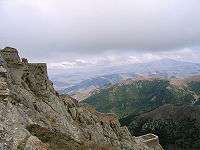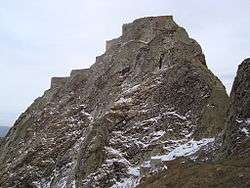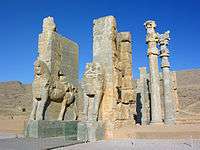Babak Khorramdin
| Babak Khorramdin | |
|---|---|
 Statue in Babek city, Nakhjavan Azerbaijan | |
| Native name | پاپک خرمدین |
| Born |
795 or 798 Kaleybar,[1] Persian Azerbaijan, Persia |
| Died |
7 January 838[2] Samarra |
| Years active | 23 |
| Known for | Leader of the Khorram-Dinān |
| Opponent(s) | Abbasid Caliphate |
| Religion | Zoroastrianism |
Bābak Khorramdin (Formally known as "Pāpak" meaning "Young Father") (Persian: بابک خرمدین, alternative spelling: Pāpak Khorramdin; 795, according to some other sources 798— January 838[3]) was one of the main Persian[4][5][6][7][8][9] revolutionary leaders of the Iranian[10] Khorram-Dinān[11] ("Those of the joyous religion"), which was a local freedom movement fighting the Abbasid Caliphate. Khorramdin appears to be a compound analogous to dorustdin "orthodoxy" and Behdin "Good Religion" (Zoroastrianism),[2] and are considered an offshoot of neo-Mazdakism.[12] Babak's Iranianizing[13] rebellion, from its base in Azerbaijan in northwestern Iran,[14] called for a return of the political glories of the Iranian[15] past. The Khorramdin rebellion of Babak spread to the Western and Central parts of Iran and lasted more than twenty years before it was defeated when Babak was betrayed. Babak's uprising showed the continuing strength in Azerbaijan of ancestral Iranian local feelings.[16]
Etymology
Babak (Persian: بابک) is a given name for Iranian males[17][18][19] It is Arabicized for Pāpak which means "young father" in Middle Persian.[20][21]
Early life
Bābak was born into a Persian[4][22] family in Azerbaijan (northwestern Iran) close to the city of Artawila (modern Ardabil). According to Wāqid ibn 'Amr Tamimi, the oldest biographer on Babak, Bābak's father was a Persian cooking-oil vendor from Ctesiphon, capital of the Sasanian Empire (modern al-Mada'in, 35 km south of Baghdad in Iraq) who left for the Azerbaijani frontier zone and settled in the village of Balālābād in the Maymadh district. According to Fasīh, his mother - a native Persian of Azerbaijan - was known as Māhrū Moon-Face/Belle.[2]
After his father's death in his early teens, Babak was given the responsibility of his two brothers and mother during a Zoroastrian ceremony in a fire temple. By the age of 18, Bābak had established himself in the city of Tabriz and was engaged in the arms trade and industry. He also served a certain Muhammad ibn Rawwad Azdi. Later on, this engagement gave him the opportunity to travel to some regions and become familiar with regions like the Caucasus, the Middle East, and the Byzantine Empire.[23]
Movement



In 755, Abu Muslim was murdered. Although he had helped the Abbasids to defeat the former Caliphs, the Umayyad dynasty, the ruling Caliph had given the order to kill him, probably because of his increasing popularity among Iranians and Non-Muslims.[2] Many Iranians, who had expected more freedom and more rights from the new rulers, could not believe that their hero was killed by the ruling Caliph whom they had considered a friend of Iran and Iranians.[24]
This incident led to many revolts, mostly by angry Zoroastrians. This, in turn, forced the Caliphs to use more violence against the Iranian population in order to keep the eastern provinces under control. The constant revolts did not come to an end in the following decades, and the Iranian population of the Caliphate was constantly being oppressed.
Babak joined the Khurramiyyah (Khorram-Dinān) where he met his wife and battle companion, Banu Khorramdin. The story of joining the Khorrami movement is being told in Waqed's account, in summary, as follows:
| “ | Two rich men named Jāvidān b. Shahrak (or Shahrak) and Abu 'Emran were then living in the highland around the mountain of Badd and contending for the leadership of the highland's Khorrami inhabitants. Jāvidān, when stuck in the snow on his way back from Zanjān to Badd, had to seek shelter at Balalabad and happened to go into the house of Babak's mother. Being poor, she could only light a fire for him, while Babak looked after the guest's servants and horses and brought water for them. Jāvidān then sent Babak to buy food, wine, and fodder. When Babak came back and spoke to Jāvidān, he impressed Jāvidān with his shrewdness despite his lack of fluency of speech. Javidan therefore asked the woman for permission to take her son away to manage his farms and properties, and offered to send her fifty dirhams a month from Babak's salary. The woman accepted and let Babak go.[2] | ” |
Under the direction of his mentor Javidan Shahrak, a leader of one of the sects of the Khorramdin, Babak's knowledge of history, geography, and the latest battle tactics strengthened his position as a favorite candidate for commander during the early wars against the Arab occupiers.
Bābak was a highly spiritual person who respected his Zoroastrian heritage. He made every possible effort to bring Iranians together and also with leaders such as Maziar to form a united front against the Arab Caliph. According to the medieval historian, Ibn Esfandyar, who composed the book Tarikh-e Tabaristan "History of Tabaristan", Maziar said:
| “ | I (Maziyar), Afshin Kheydar son of Kavus, and Babak had made an oath and allegiance that we re-take the government back from the Arabs and transfer the government and the country back to the family of Kasraviyan (Sassanids)"[25] | ” |
However, one of the most dramatic periods in the history of Iran was set under Bābak's leadership between 816-837. During these most crucial years, they not only fought against the Caliphate, but also for the preservation of Persian language and culture.
After the death of Javidan, Babak married Javidan's wife and became the Khorramis' leader, sometime in the year 816-17 during al-Ma'mun's reign. Babak incited his followers to rise in rebellion against the caliphal regime. The reports state that Babak called Persians to arms, seized castles and strong points, thereby barring roads to his enemies. Gradually a large multitude joined him.[2]
According to Vladimir Minorsky, around the 9th-10th century:[26]
| “ | "The original sedentary population of Azarbayjan consisted of a mass of peasants and at the time of the Arab conquest was compromised under the semi-contemptuous term of Uluj ("non-Arab") - somewhat similar to the raya (*ri’aya) of the Ottoman empire. The only arms of this peaceful rustic population were slings, see Tabari, II, 1379-89. They spoke a number of dialects (Adhari (Azari), Talishi) of which even now there remains some islets surviving amidst the Turkish speaking population. It was this basic population on which Babak leaned in his revolt against the caliphate. | ” |
There had long been groups of Khorramis scattered in Isfahan, Azerbaijan, Ray, Hamadan, Armenia, Gorgan, and elsewhere in Iran,[2] and there had been some earlier Khorrami revolts, e.g., in Gorgan jointly with Red Banner (Sorkh-'alamān) Bātenis in the caliph Al-Mahdi's reign in 778-79, when 'Amr b. 'Ala', the governor of Tabarestān, was ordered to repulse them, and at Isfahan, Ray, Hamadan, and elsewhere in Harun al-Rashid's realm, when 'Abd-Allah b. Malek and Abu Dolaf 'Ejli put them down on caliph's behalf - but none had the scale and duration of Babak's revolt, which pinned down caliphal armies for twenty years. After Babak's emergence, the Khorrami movement was centered in Azerbaijan and reinforced with volunteers from elsewhere, probably including descendants of Abu Muslim's supporters and other Iranian enemies of the 'Abbasid caliphate. The figures given for the strength of Babak's Khorramdinan army, such as 100,000 men (Abu'l-Ma'ali), 200,000 (Mas'udi), or innumerable (Baghdadi) are doubtless highly exaggerated but at least indicate that it was large.[2] At that time of Babak, there were Khorramis scattered in many regions of Iran, besides Azerbaijan, reportedly in Tabarestan, Khorasan, Balkh, Isfahan, Kashan, Qom, Ray, Karaj, Hamadan, Lorestan, Khuzestan as well as in Basra, and Armenia.[2]
Tabari records that Babak claimed he possessed Javadan's spirit and that Babak became active in 816-817. In 819-820 Yahya ibn Mu'adh fought against Babak, but could not defeat him. Two years later Babak vanquished the forces of Isa ibn Muhammad ibn Abi Khalid. In 824-825 the caliphal general Ahmad ibn al Junayd was sent against Babak. Babak defeated and captured him.
In 827-828 Muhammad ibn Humayd Tusi was dispatched to fight Babak. He won a victory and sent some captured enemy, but not Babak, to al-Ma'mun. However, about two years later, on June 9, 829, Babak won a decisive victory over this general at Hashtadsar. Muhammad ibn Humayd lost his life. Many of his soldiers were killed. The survivors fled in disarray.
In 835-836 the caliph al-Mu'tasim sent his outstanding general Afshin against Babak. Afshin rebuilt fortresses. He employed a relay system to protect supply caravans. Babak tried to capture the money being sent to pay Afshin's army, but was himself surprised, lost many men and barely escaped. He did succeed in capturing some supplies and inflicting some hardship on his enemies. Amongst Babak's commander, various names have been mentioned including Azin, Rostam, Tarkhan, Mua’wiyah and Abdullah.[27]
The next year Babak routed the forces of Afshin's subordinate, Bugha al-Kabir. In 837-838 al-Mu'tasim reinforced Afshin and provided him clear military instructions. Patiently following these enabled Afshin to capture Babak's stronghold of Badhdh. Babak escaped. Al-Mu'tasim sent a safety guarantee for Babak to Afshin. This was taken to Babak who was very displeased. He said:
"Better to live for just a single day as a ruler than to live for forty years as an abject slave."
He decided to leave the country for the Byzantine Empire and on his way Babak met Sahl Smbatean (Sahl ibn Sunbat in Arab sources), Prince of Khachen, who was Armenian due to the Armenian historiography and Caucasian Albanian due to the Azerbaijani historiography. Sahl Smbatian, however, handed Babak over to Afshin, for big amount of reward. Al-Mu'tasim commanded his general to bring Babak to him. Afshin informed Babak of this and told him since Babak might never return, this was the time to take a last look around. At Babak's request, Afshin allowed his prisoner to go to Badhdh. There Babak walked through his ruined stronghold one night until dawn.
Eventually, Bābak, his wife, and his warriors were forced to leave Ghaleye Bābak after 23 years of constant campaigns.
Death
He was eventually betrayed by Afshin and was handed over to the Abbasid Caliph. During Bābak's execution, the Caliph's henchmen first cut off his legs and hands in order to convey the most devastating message to his followers. The legend says that Bābak bravely rinsed his face with the drained blood pouring out of his cuts, thus depriving the Caliph and the rest of the Abbasid army from seeing his pale face, a result of the heavy loss of blood.[2][28] He was then gibbeted alive whilst sewn into a cow's skin with the horns at ear level to gradually crush his head as it dried out.[29]
See Abdolhussein Zarrinkoob’s “Two Centuries of Silence” for more on Papak’s life, his twenty years of struggle against the Muslim Arabs during the Ma’mun and Mu'tasim caliphate, and death.[30]
Legacy
Babak Khorramdin was not well known outside academia until the 20th century; however, due to Soviet nation building efforts and Babak's following of teaching of Mazdak with its pseudo-communist and socialist themes, Babak Khorramdin was proclaimed a national hero in the Azerbaijan Soviet Socialist Republic. For example, the Soviet era scholar Ziya Bunyadov, claimed that "Babak was a national hero of Azerbaijani people" while the Russian ethnologist, historian and anthropologist Victor Schnirelmann dismisses Bunyadov's theory, criticizing Bunyadov for not mentioning that Babak spoke Persian, and ignoring the witness accounts of Babak's contemporaries who call him Persian.[31] To this day, in the modern Republic of Azerbaijan, Babak is a cult figure and celebrated as a national hero.[32] In modern Iran, due to the rise of nationalism in the 20th century, and renewed interest in pre-Islamic Iran, Babak Khorramdin was rediscovered during the reign of Reza Shah, and is celebrated as a national hero.[33][34] However, Babak remains a controversial figure in the Islamic Republic, whose idolization is criticized by some Shia clerics.[33][35]
Bibliography
Muhammad ibn Jarir al-Tabari History v. 32 "The Reunification of the Abbasid Caliphate", transl. C.E. Bosworth, SUNY, Albany, 1987; v. 33 "Storm and Stress along the Northern Frontiers of the Abbasid Caliphate", transl. C.E. Bosworth, SUNY, Albany, 1991
See also
References
- ↑ saeed Nafīsī, Bābak-e Ḵorramdīn, 2nd ed., Tehran, 1342 Š./1963, p.152
- 1 2 3 4 5 6 7 8 9 10 Encyclopædia Iranica, "Babak Khorrami" by G.H. Yusofi
- ↑ 3 Safar 223 A.H.
- 1 2
- ↑ Whittow (1996), The Making of Orthodox Byzantium, 600-1025. New studies in medieval history, London: Macmillan, pp. 195, 203 & 215
Azerbaijan was the scene of frequent anti-caliphal and anti-Arab revolts during the eighth and ninth centuries, and Byzantine sources talk of Persian warriors seeking refuge in the 830s from the caliph's armies by taking service under the Byzantine emperor Theophilos. [...] Azerbaijan had a Persian population and was a traditional centre of the Zoroastrian religion. [...] The Khurramites were a [...] Persian sect, influenced by Shiite doctrines, but with their roots in a pre-Islamic Persian religious movement.
- ↑
- ↑
- ↑
- ↑
- ↑ Bernard Lewis (1991), "The Political Language of Islam", University of Chicago Press, pp 314. "The last and most nearly successful of the Iranian movements, however was that of Babak, who established his independence in Iran's Azerbaijan early in al-Mamun's reign."
- ↑ "Babak." Encyclopædia Britannica. 2007. Encyclopædia Britannica Online. 7 June 2007 <http://www.britannica.com/eb/article-9002797>.
- ↑ Dr Farhad Daftary C. E. Bosworth, Afshin; accessed March 15, 2007.
- ↑ Bernard Lewis (1991), "The Political Language of Islam", University of Chicago Press, pp 482):""Babak's Iranianizing rebellion in Azerbaijan gave occasion for sentiments at the capital to harden against men who were sympathetic to the more explicitly Iranian tradition"
- ↑ F. Daftary (1999) Sectarian and National Movements in Iran, Khurasan and Transoxania During Umayyad and Early 'Abbasid Times In History of Civilizations of Central Asia, vol. IV, part One, ed. M. S. Asimov and C. E. Bosworth. Paris: UNESCO Publishing, pp. 41-60. excerpt from pg 50: "The activities of the Khurammiya reached their peak in the movement of Babak al-Khurrami, whose protracted rebellion based in north-western Iran seriously threatened the stability of the Abbassid caliphate.... This revolt lasting for more than twenty three years, soon spread from Azerbaijan (North/West Iran) to western and central parts of Iran.
- ↑ Kathryn Babayan, "Mystics, monarchs, and messiahs ", Harvard CMES, 2002. pg 138: "Babak revolted in Azerbaijan (816-838), evoking Abu Muslim as a heroic symbol..and called for a return to the Iranian past"
- ↑ C.E. Bosworth, "AZERBAIJAN iv. Islamic History to 1941" in Encyclopaedia Iranica . Excerpt: "An episode like Bābak’s uprising showed the continuing strength in Azerbaijan of ancestral Iranian local feelings."
- ↑ Huart, Cl. "Bābek". Encyclopaedia of Islam, First Edition (1913-1936). E.J. Brill. Retrieved 2012-04-25.
- ↑ Sourdel, D. "Bābak". Encyclopaedia of Islam, Second Edition. E.J. Brill. Retrieved 2012-04-25.
- ↑ "BĀBAK",Encyclopedia of Islam, second edition
- ↑ "Bāpak". Encyclopedia Iranica.
- ↑ Ali-Akbar Dehkhoda. "babak (in persian)". Dehkhoda Dictionary. tehran university press. Archived from the original on 2012-02-23. Retrieved 2012-04-25.
- ↑
- ↑ "Khorramis in Byzantium" in Encyclopædia Iranica by Evangelos Venetis. Access date, Nov 5, 2007.
- ↑ CAIS News, Restoration of Fortress of Babak Khorramdin to Continue, May 16, 2004.
- ↑ Said Nafisi, Babak Khorramdin Delawar-e-Azerbaijan (Babak Khorramdin, the braveheart of Azerbaijan), Tabesh Publishers, Tehran 1955, pg 57, actual quote from Ibn Esanfiyar: Persian: من (مازیار) و افشين خيدر بن کاوس و بابک هر سه از دير باز عهد و بيعت کرده ايم و قرار داده بر آن که دولت از عرب بازستانيم و ملک و جهانداري با خاندان کسرويان نقل کنيم
- ↑ V. Minorsky, Studies in Caucasian History, Cambridge University Press, 1957, pg 112
- ↑ Said Nafisi, Babak Khorramdin Delawar-e-Azerbaijan (Babak Khorramdin, the brave-heart of Azerbaijan), Tabesh Publishers, Tehran 1955
- ↑ CAIS News, Restoration of Fortress of Babak Khorramdin to Continue, May 16, 2004
- ↑ The golden age of Islam by Maurice Lombard, page 152, ISBN 1-55876-322-8, ISBN 978-1-55876-322-7
- ↑ ʻAbdolhossein Zarrinkoob (2016). Two Centuries of Silence) translated by Avid Kamgar (1st ed. 2016 ed.). Bloomington, USA: AuthorHouse. ISBN 978-1-52462-253-4.pp.175-190
- ↑ Shnirelman, V.A.(2001), 'The value of the Past: Myths, Identity and Politics in Transcaucasia', Osaka: National Museum of Ethnology.pp 123: "Having claimed that, Buniiatov failed to mention that Babek spoke Persian, and ignored the witnesses of contemporaries who called him the "Persian".
- ↑ David Menashri. Central Asia Meets the Middle East. Portland Frank Cass, 1998
- 1 2 Michael M.J. Fischer, Mehdi Abedi, "Debating Muslims: cultural diologues in postmodern and tradition", University of Wisconsin Press, 1990. pg 191
- ↑ Zabiollah Safa,"Daliraan-i Jaanbaaz" (Brave Heroes), Firdawsi Publishers, Tehran, 1998.
- ↑ Ahmed Hashim, International Institute for Strategic Studies, p80
Sources
- SOURDEL, D (1986). "BĀBAK". Encyclopaedia of Islam. vol.1 (2nd ed.). Leiden: E. J. Brill. p. 844. ISBN 90-04-08114-3.
| Wikimedia Commons has media related to Babak Khorramdin. |
| Wikiquote has quotations related to: Babak Khorramdin |
